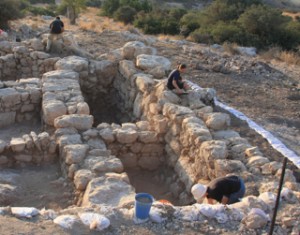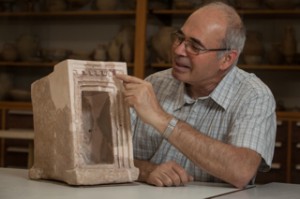
By Marney Blom
3,000-years-ago a young shepherd named David walked the hilltop of Khirbet Qeiyafa, unintimidated by the taunts of Goliath – the giant whom he would later slay in the Elah Valley below. After David’s ascendance to the throne, this same elevation, 30-km from Jerusalem, became a strategic city along the border with Israel’s arch-enemy – the Philistines.
Today the remains of the ancient fortified city have become an archaeological dig site, lead by Prof. Yosef Garfinkel, the Yigal Yadin Professor of Archaeology at the Hebrew University in Jerusalem.
“Anybody in the world that wants to know something about the time of King David, the urbanization, the diet, the pottery … must come here to Khirbet Qeiyafa to look at the evidence,” said Garfinkel.
During a recent press conference and field tour Garfinkel presented his latest discoveries – sacred artifacts, evidence of Israel’s devotion to God during the time of King David.
“You can see that we have no animal or human figurines at all in our site. This is totally different to Canaanite, Philistine, or Mesopotamian [worship]. All over … in cultic places, shrines [and] temples we have a lot of human and animal figurines,” noted Garfinkel.
Unlike the motifs found on the pagan cult objects of the same time period, the absence of animal or human figurines strengthens the credibility of the biblical accounts of Israel’s ancient religious practices – which were based on the commands of God given to Moses – and is evidence that the people of David’s kingdom were living by these standards.
All the objects were discovered in specified rooms within homes built directly into the wall of the city. The “holy rooms” were set apart, and according to Garfinkel, may be examples of an early prototype of the Holy of Holies of Solomon’s Temple.
The strategic positioning of these ancient rooms both within the city walls and near the city gate could indicate the pre-eminence of Israelite devotion to God factored into every day life 3,000 years ago. Walls and gates were prime property – places of authority and fortification with a clear view to the advances of the enemy especially if located on the border with a hostile nation, as was the case of Khirbet Qeiyafa.

And thanks to Garfinkel’s work, obscure technical biblical terms – apparently lost over the millennia – now have new clarity. Designs etched into the sacred objects are consistent with the biblical descriptions of motifs found in Solomon’s and Ezekiel’s Temples. For example, the “triglyth” or three-leaf structure – of which the earliest known example is found in Khirbet Qeiyafa – also appears on columns of Solomon’s temple. What some translations of Scripture refer to as windows, window frames or architraves, from the artifacts are clearly distinguishable as triple recess doors – the design that appears in Solomon’s temple and in the heavenly temple of Ezekiel’s vision.
So what do the archaeological discoveries of Khirbet Qeiyafa do for the credibility of the Bible?
“This is what [makes] the biblical account a real story,” contends Garfinkel. “If it [were] fantasy you [would] not find evidence that confirms it.
I cannot ignore the biblical text and I cannot ignore the archaeology. We need to work together.”
Marney Blom is news director for the Acts News Network.
Copyright © Acts News Network, Inc.
